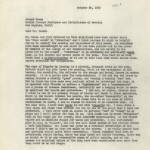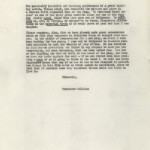
Haley Williams is a psychology/Plan I Honors senior in Dr. Elon Lang’s “Drama in the Archives” course. In the course, students used resources at the Harry Ransom Center to better understand plays, texts, dramatists, cultures from which they are drawn, and the archival process itself. Below, Williams shares her experience in the class.
In my first two years of undergrad, I often passed the “big glass buildings with the pretty pictures” on my way to and from class. I had even visited the exhibitions on occasion and meandered over to listen to a lecture from time to time. However, in my mind, the Harry Ransom Center was for graduate students and professors, a place off limits to undergraduate students such as me. Thankfully, this semester I was proven wrong.
One of my classes in the Fall 2014 semester focused on reading several plays with visits to the Ransom Center to comb through the archives of these playwrights. The final was a research project on one of the plays we had read in class. I had previously written a paper about A Streetcar Named Desire and knew this is where my research would begin. To do this, I was fortunate to have access to not only the archive of Williams himself but also the wealth of manuscripts, books, papers, letters, and notes from the Audrey Wood and Stella Adler collections. While using the Audrey Wood collection, I found folders about the production of the 1951 movie starring Marlon Brando and Vivien Leigh. One letter I found inspired further research into the different endings of the play and how they affected the meaning of the play.
In the letter to Joseph Breen, head of Hollywood’s motion picture production code office, Williams notes he has heard about the production company potentially removing the rape scene from the movie. Williams explains to Breen that this is not possible, as the rape of Blanche by Stanley is “a pivotal, integral truth in the play, without which the play loses its meaning, which is the ravishment of the tender, the sensitive, the delicate, by the safe and brutal forces in modern society. It is a positive plea for comprehension.” He goes on to explain that he is willing to do whatever it takes to keep this within the movie because without the scene, the importance of the play will be completely removed.
What Williams really thought about the rape scene can be further examined when looking at some of the earlier drafts of the play. In an early draft of scenes 10 and 11, the rape scene that has become iconic thanks to the performance of Brando and Leigh is absent, and instead a consensual sex scene exists in its place. Following this scene is a morning of domestic bliss and tranquility between two consensual sexual partners. Instead of a brutal scene of violence, we see Blanche helping Stanley tie his tie and pick out a shirt to wear. The scene also ends with Blanche planning to leave using the bus ticket Stanley got her for her birthday, not with her removal to the asylum by the doctor and matron. By changing this one scene, Williams completely reworks the characters of Stanley and Blanche, showing that he experimented early on with alternatives for the rape scene that he later defends emphatically in his letter to Breen.
These endings to the play provide the path by which one can trace the progression of the play and possible reasons why Williams made these decisions. As these were early drafts of the play, the manuscript had lines marked out, suggestions for changing certain words, and even changes to names. Because he considered the rape of Blanche by Stanley to be important because of the symbolic message that it represented, he was able to understand, even early in the writing process, that this scene was imperative to his play. Having access to the Ransom Center’s collections as a student to discover these things for myself is something that few are able to claim and something that I am thankful we are able to do as students at The University of Texas at Austin.
Click on thumbnails to view larger images.


